In late 1914, Campbell and Sons of Ravenhill Road were awarded the contract to construct the camp and advertised for “galvanised iron fitters for Newtownards Camp”. The erection of the buildings was carried out under the direction of James Sinclair Jackson, representing Swiney, Ferguson and Croasdaile of Royal Avenue. He was wounded in 1916 whilst serving with the Royal Engineers.
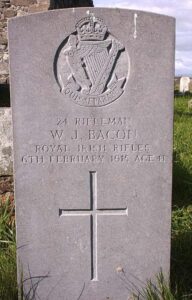 In February 1915, Major-General Friend, Commander-in-Chief of the Forces in Ireland, inspected the men of the 12th Battalion Royal Irish Rifles and the first death of a soldier from the camp occurred. Rifleman William James Bacon (35) died of influenza and pneumonia at Newtownards Workhouse Infirmary on 6th February. His body was returned to his home in Portrush for burial in Ballywillan Cemetery with full military honours.
In February 1915, Major-General Friend, Commander-in-Chief of the Forces in Ireland, inspected the men of the 12th Battalion Royal Irish Rifles and the first death of a soldier from the camp occurred. Rifleman William James Bacon (35) died of influenza and pneumonia at Newtownards Workhouse Infirmary on 6th February. His body was returned to his home in Portrush for burial in Ballywillan Cemetery with full military honours.
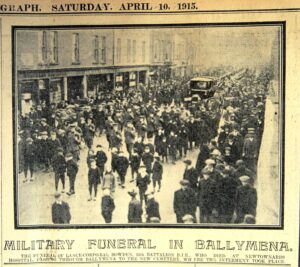
An outbreak of scarlet fever was to claim the life of Lance-Corporal John Bowden (19) of Harryville at Newtownards Fever Hospital on 1st April 1915. He was buried with full military honours in Ballymena New Cemetery on 3rd April.
In the same month, John Cooper, a regimental librarian, lost the sight in one eye after being struck by a stone chip from road-building work at the camp. He was discharged from the army and had to support a wife and six children on an allowance of twelve shillings and sixpence per week. A year later his claim for damages against the camp contractors had still not been resolved.
In September 1915, the 6th (Inniskilling) Dragoons’ Service Squadron, the Ulster Division’s cavalry unit, moved to Newtownards Camp in preparation for being deployed to France. The Catch-my-Pal Society erected a recreation hut at the camp around the same time. It was a place where the soldiers could gather to read, play games and to write letters home.
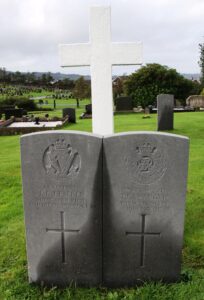 In 1916, the camp became a training base for the Ulster Division’s reserve battalions. On 17th December 1917, men from the 19th Battalion Royal Irish Rifles were carrying out bomb throwing practice when a fatal accident occurred. Corporal Leonard Parker, who had recently been invalided from the Western Front, was leading the practice when a bomb that he was preparing to throw exploded prematurely. He was killed instantaneously and two officers, Major Hall and Lieutenant Currie, were seriously injured. Major William Charles Hall (52) died of shrapnel wounds later the same day. Corporal Leonard Edward John Parker (20), a son of Edward and Lilian Parker of Dartmouth Road, Forest Hill, London, was interred in Movilla Cemetery in Newtownards.
In 1916, the camp became a training base for the Ulster Division’s reserve battalions. On 17th December 1917, men from the 19th Battalion Royal Irish Rifles were carrying out bomb throwing practice when a fatal accident occurred. Corporal Leonard Parker, who had recently been invalided from the Western Front, was leading the practice when a bomb that he was preparing to throw exploded prematurely. He was killed instantaneously and two officers, Major Hall and Lieutenant Currie, were seriously injured. Major William Charles Hall (52) died of shrapnel wounds later the same day. Corporal Leonard Edward John Parker (20), a son of Edward and Lilian Parker of Dartmouth Road, Forest Hill, London, was interred in Movilla Cemetery in Newtownards.
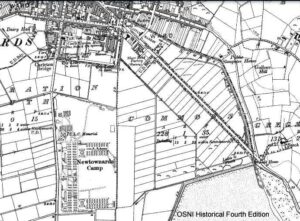
By 1918, the camp was the home base of the Irish Command Labour Corps, which remained at the camp until the end of 1919. In September 1919, a memorial to the men of the ICLC who had served in the Great War was erected near the camp’s recreation ground. The location is marked on the OSNI Historical Fourth Edition map. It is not known what happened to the memorial.
In the early 1920s, the camp became the training depot for the RUC and Ulster Special Constabulary. In January 1921, the evangelist Captain Gipsy Pat Smith, who had served in the Great War, addressed over 400 men at the YMCA Hut in the camp. Throughout the 1920s, the camp was used for annual shooting competitions by the police and for sporting events.
In August 1921, a fatal incident occurred when three Specials were returning to camp from Ballygowan in a private car. On approaching the North Gate, the car slowed but one of the camp guards fired a shot which struck Special Constable Thomas Reid (27) in the chest. Although he was treated by medical staff at the camp, Thomas died on 31st July at the Royal Victoria Hospital.
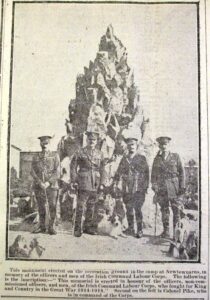 In May 1922, Sergeant William Lamont lost his life in another accident at Newtownards Camp. His wife, Martha (33) died at their home in Fourth Street on 5th May 1922. The news was relayed to the guardhouse the following morning. When Sergeant Blythe called at Sergeant Lamont’s cubicle in Hut 15 to deliver the news, he noticed a strong smell of gas and discovered William lying prone. Sergeant Blythe, CSM Cherry and Sergeant Barnes (RAMC) attempted artificial respiration to no avail. Dr Jamison, the camp’s Medical Officer, gave evidence at the Coroner’s Enquiry that William had died of asphyxia caused by gas poisoning. William and Martha Lamont are buried in Belfast City Cemetery Glenalina Extension.
In May 1922, Sergeant William Lamont lost his life in another accident at Newtownards Camp. His wife, Martha (33) died at their home in Fourth Street on 5th May 1922. The news was relayed to the guardhouse the following morning. When Sergeant Blythe called at Sergeant Lamont’s cubicle in Hut 15 to deliver the news, he noticed a strong smell of gas and discovered William lying prone. Sergeant Blythe, CSM Cherry and Sergeant Barnes (RAMC) attempted artificial respiration to no avail. Dr Jamison, the camp’s Medical Officer, gave evidence at the Coroner’s Enquiry that William had died of asphyxia caused by gas poisoning. William and Martha Lamont are buried in Belfast City Cemetery Glenalina Extension.
Whilst the camp continued to be used for shooting competitions and for training purposes by the British Army (e.g., 300 men of the London Irish Rifles were quartered at the camp in July 1931 before moving to Victoria Barracks, Belfast), the numbers of men stationed in the camp declined. In March 1926, the Minister of Home Affairs made a statement about the camp in response to a written question from Major David Graham Shillington, MP for Armagh. The Minister reported that the camp was held on a yearly lease from the War Department at a cost of £1,080 p.a. and that 145 men, including twenty Special Constables, were quartered at the camp. The lease could be cancelled by either side at six months’ notice.
Following the creation of the airfield at Newtownards in the mid-1930s and the outbreak of the Second World War, the camp returned to military duty … but that is another story.
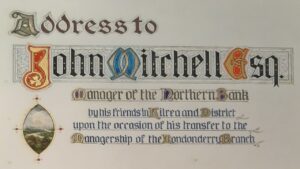 During the clear out of the Northern Bank (Danske Bank) branch in Kilrea, Co. Londonderry prior to its closure in December 2020, an ‘Illuminated Address’ book was found in storage. This hardback book, in ‘used’ condition consists of 8 thick card pages bound in a red cover with gold leaf patterns embossed on each cover. It is dated the 27th October 1923 and was given to ‘John Mitchell, Manager of the Northern Bank by his friends in Kilrea and District upon the occasion of his transfer to the Managership of the Londonderry Branch’. The book was designed and printed by ‘Carey and Thomson’ of Royal Avenue, Belfast. In addition to the 3 pages of the address and the list of subscribers, there are water colour pictures of ‘The Bann Bridge, Kilrea’, ‘The Northern Bank Kilrea’, ‘Kilrea From Railway Station’ and ‘The Golf Links Kilrea’.
During the clear out of the Northern Bank (Danske Bank) branch in Kilrea, Co. Londonderry prior to its closure in December 2020, an ‘Illuminated Address’ book was found in storage. This hardback book, in ‘used’ condition consists of 8 thick card pages bound in a red cover with gold leaf patterns embossed on each cover. It is dated the 27th October 1923 and was given to ‘John Mitchell, Manager of the Northern Bank by his friends in Kilrea and District upon the occasion of his transfer to the Managership of the Londonderry Branch’. The book was designed and printed by ‘Carey and Thomson’ of Royal Avenue, Belfast. In addition to the 3 pages of the address and the list of subscribers, there are water colour pictures of ‘The Bann Bridge, Kilrea’, ‘The Northern Bank Kilrea’, ‘Kilrea From Railway Station’ and ‘The Golf Links Kilrea’.
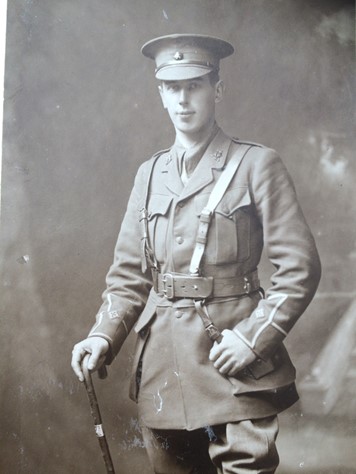 On this day in 1916 Lieutenant Edward Workman died in the Duchess of Westminster hospital, Le Touquet, France where he was being treated for wounds received exactly one week before in a raid on German trenches; it initially was thought that his wounds were not serious.
On this day in 1916 Lieutenant Edward Workman died in the Duchess of Westminster hospital, Le Touquet, France where he was being treated for wounds received exactly one week before in a raid on German trenches; it initially was thought that his wounds were not serious. In February 1915, Major-General Friend, Commander-in-Chief of the Forces in Ireland, inspected the men of the 12th Battalion Royal Irish Rifles and the first death of a soldier from the camp occurred. Rifleman William James Bacon (35) died of influenza and pneumonia at Newtownards Workhouse Infirmary on 6th February. His body was returned to his home in Portrush for burial in Ballywillan Cemetery with full military honours.
In February 1915, Major-General Friend, Commander-in-Chief of the Forces in Ireland, inspected the men of the 12th Battalion Royal Irish Rifles and the first death of a soldier from the camp occurred. Rifleman William James Bacon (35) died of influenza and pneumonia at Newtownards Workhouse Infirmary on 6th February. His body was returned to his home in Portrush for burial in Ballywillan Cemetery with full military honours.
 In 1916, the camp became a training base for the Ulster Division’s reserve battalions. On 17th December 1917, men from the 19th Battalion Royal Irish Rifles were carrying out bomb throwing practice when a fatal accident occurred. Corporal Leonard Parker, who had recently been invalided from the Western Front, was leading the practice when a bomb that he was preparing to throw exploded prematurely. He was killed instantaneously and two officers, Major Hall and Lieutenant Currie, were seriously injured. Major William Charles Hall (52) died of shrapnel wounds later the same day. Corporal Leonard Edward John Parker (20), a son of Edward and Lilian Parker of Dartmouth Road, Forest Hill, London, was interred in Movilla Cemetery in Newtownards.
In 1916, the camp became a training base for the Ulster Division’s reserve battalions. On 17th December 1917, men from the 19th Battalion Royal Irish Rifles were carrying out bomb throwing practice when a fatal accident occurred. Corporal Leonard Parker, who had recently been invalided from the Western Front, was leading the practice when a bomb that he was preparing to throw exploded prematurely. He was killed instantaneously and two officers, Major Hall and Lieutenant Currie, were seriously injured. Major William Charles Hall (52) died of shrapnel wounds later the same day. Corporal Leonard Edward John Parker (20), a son of Edward and Lilian Parker of Dartmouth Road, Forest Hill, London, was interred in Movilla Cemetery in Newtownards.
 In May 1922, Sergeant William Lamont lost his life in another accident at Newtownards Camp. His wife, Martha (33) died at their home in Fourth Street on 5th May 1922. The news was relayed to the guardhouse the following morning. When Sergeant Blythe called at Sergeant Lamont’s cubicle in Hut 15 to deliver the news, he noticed a strong smell of gas and discovered William lying prone. Sergeant Blythe, CSM Cherry and Sergeant Barnes (RAMC) attempted artificial respiration to no avail. Dr Jamison, the camp’s Medical Officer, gave evidence at the Coroner’s Enquiry that William had died of asphyxia caused by gas poisoning. William and Martha Lamont are buried in Belfast City Cemetery Glenalina Extension.
In May 1922, Sergeant William Lamont lost his life in another accident at Newtownards Camp. His wife, Martha (33) died at their home in Fourth Street on 5th May 1922. The news was relayed to the guardhouse the following morning. When Sergeant Blythe called at Sergeant Lamont’s cubicle in Hut 15 to deliver the news, he noticed a strong smell of gas and discovered William lying prone. Sergeant Blythe, CSM Cherry and Sergeant Barnes (RAMC) attempted artificial respiration to no avail. Dr Jamison, the camp’s Medical Officer, gave evidence at the Coroner’s Enquiry that William had died of asphyxia caused by gas poisoning. William and Martha Lamont are buried in Belfast City Cemetery Glenalina Extension.